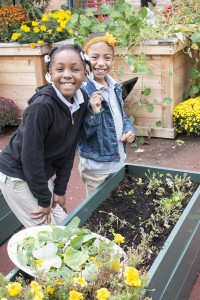 August is back-to-school time. For an increasing number of children, school will involve gardening. But they need the help of experienced gardeners—especially those who know what to do with a cold frame.
August is back-to-school time. For an increasing number of children, school will involve gardening. But they need the help of experienced gardeners—especially those who know what to do with a cold frame.
School gardens are one kind of volunteer project that Master Gardener volunteers like me often help with. Experience has shown that there’s a little more to it than scattering a few seeds in the ground.
Some teachers love the idea of gardening, and see lots of opportunities to hang lessons in science, math, and even reading and writing on the process of planning and creating a vegetable garden. They realize that children learn more from hands-on experience than from classroom lessons, and that many have little idea of where their food comes from. But enthusiastic as they may be, teachers often have little gardening experience themselves and don’t really grasp what’s involved.
Other teachers resist the idea, because they think a garden will be distracting and messy and cause extra work. Principals often view time kids spend in a garden as time stolen from preparation for standardized tests. There frequently is no slack in a tight school budget for tools, raised beds, soil or seeds, and no obvious place to put a garden: Many schoolyards are entirely paved.
These obstacles may be overcome with research, planning, persuasion, and hustling for grants. But another difficulty is the mismatch between the school year and the vegetable gardening year: Most schools let out for the summer just a couple of weeks after the average last frost date. There’s no one to water and weed over the summer, and the kids won’t be around to see tomatoes ripen.
One of the ways to get around this is to start seeds indoors so children can at least see a plant sprout from a seed before the end of the school year. Many classrooms have a sunny windowsill that will do the job. If the children plant speedy radishes or cold-tolerant lettuce or spinach, they may even be able to eat a salad they grew themselves before school is out (although radishes and salads are admittedly a tough sell for grade-schoolers). With a simple cold frame, these crops can be planted outside early in spring.
The absolute key to a successful school garden, though, is experienced gardeners to help. Sometimes these are parents, sometimes Master Gardeners or other volunteers. They can help devise a realistic plan, come to school to show techniques, and maybe even tend the garden over the summer so that, in September, there are a few tomatoes to share. Or set up that cold frame.
There’s help for teachers interested in starting a school garden. The National Gardening Association has many online resources. In Chicago, where I live, a conservation nonprofit called Openlands has a Building School Gardens program that holds training workshops for teachers, and there are similar programs in some other cities. To find grant programs for startup funding, check out the America in Bloom website.
But the first step, if you’re thinking of starting a school garden, is to find a gardener to help—soon, so the planning and prep can go on during the winter. Then, with a sunny windowsill or even a cold frame, children can experience the wonder of growing their own food in spring.


